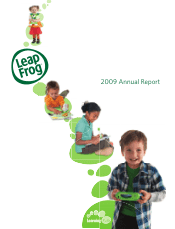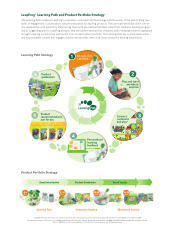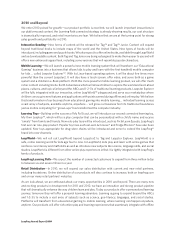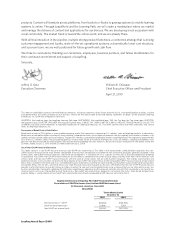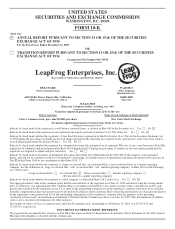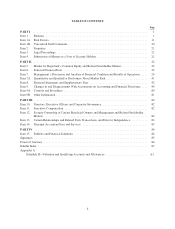LeapFrog 2009 Annual Report Download - page 11
Download and view the complete annual report
Please find page 11 of the 2009 LeapFrog annual report below. You can navigate through the pages in the report by either clicking on the pages listed below, or by using the keyword search tool below to find specific information within the annual report.
PART I
ITEM 1. BUSINESS
LeapFrog (“LeapFrog” or “we”), founded in 1995 and incorporated in 1997 in the State of Delaware, designs,
develops and markets a family of innovative technology-based learning platforms and related proprietary content
for infants through age twelve, both at home and in schools around the world. Our product portfolio consists of
standalone learning toys, interactive reading systems, educational gaming systems, and software-based book and
game content. LeapFrog has developed a number of learning platforms, including the Leapster Learning Game
System and Tag and Tag Junior Reading Systems that support a broad library of software titles. These and other
of our products are part of our proprietary online Learning Path, which provides parents with personalized
learning feedback and children with richer interactive learning experiences. We have created more than 340
interactive software titles, covering subjects such as phonics, reading, writing, and math. Our products are
available in four languages and are sold globally through retailers, distributors, directly to consumers via the
leapfrog.com web-store, and directly to schools. Our mission at LeapFrog is to inspire children with a lifelong
love of learning and reading and to empower parents with personalized tools that will help them advance their
children’s learning progress.
Since April 2004 we have been a majority-owned subsidiary of Mollusk Holdings, LLC (“Mollusk”), an entity
controlled by Lawrence J. Ellison, Chief Executive Officer of Oracle Corporation. LeapFrog is headquartered in
Emeryville, California.
Business Overview
During the second half of 2008, the effects of a nearly unprecedented meltdown in the global economy began to
accelerate. Consumer product companies were severely affected due to weaker consumer spending, particularly
with respect to discretionary items. The prevailing adverse macroeconomic conditions continued to deteriorate
into December of 2008. With 2008 holiday sales significantly below expectations, many retailers were left with a
substantial inventory overhang heading into 2009.
High retailer inventory levels adversely impacted our 2009 net sales, particularly during the first three quarters,
which, for our products, were 40% lower than the same period of 2008. Retailers generally responded to the
economic crisis by reducing inventory levels and also delaying orders to more closely match the timing of their
forecasted sell-through. Consumers also became increasingly price conscious purchasing a higher proportion of
our lower priced or discounted items than in past years.
We employed several strategies in 2009 designed to respond to these trends including increased use of discount
and promotion programs, tight inventory production management, the launch of several lower priced products
and heightened focus on reducing our cost structure.
We closely managed our inventory production throughout 2009 in response to delayed retailer orders and to
avoid over production. Closer production management, combined with a modestly stronger than forecasted retail
environment during the fourth quarter, resulted in some items being out of stock during the holiday season. We
ended 2009 with our lowest reported year-end inventory level since becoming a publicly traded company.
We launched our attractively priced Scout line of toys and discounted several products throughout 2009 in
response to the shift in consumer preference toward lower priced items. Our learning toy business grew to 33%
of total net sales for the year ended December 31, 2009, up from 26% for the same period of 2008.
As a result of our increased use of promotion and discounting programs, retail inventory levels were brought
down to appropriate levels during the third quarter of 2009. However, these programs had a detrimental effect on
our gross margin, which declined three percentage points through the first three quarters of 2009 as compared to
the same period of 2008.
1

